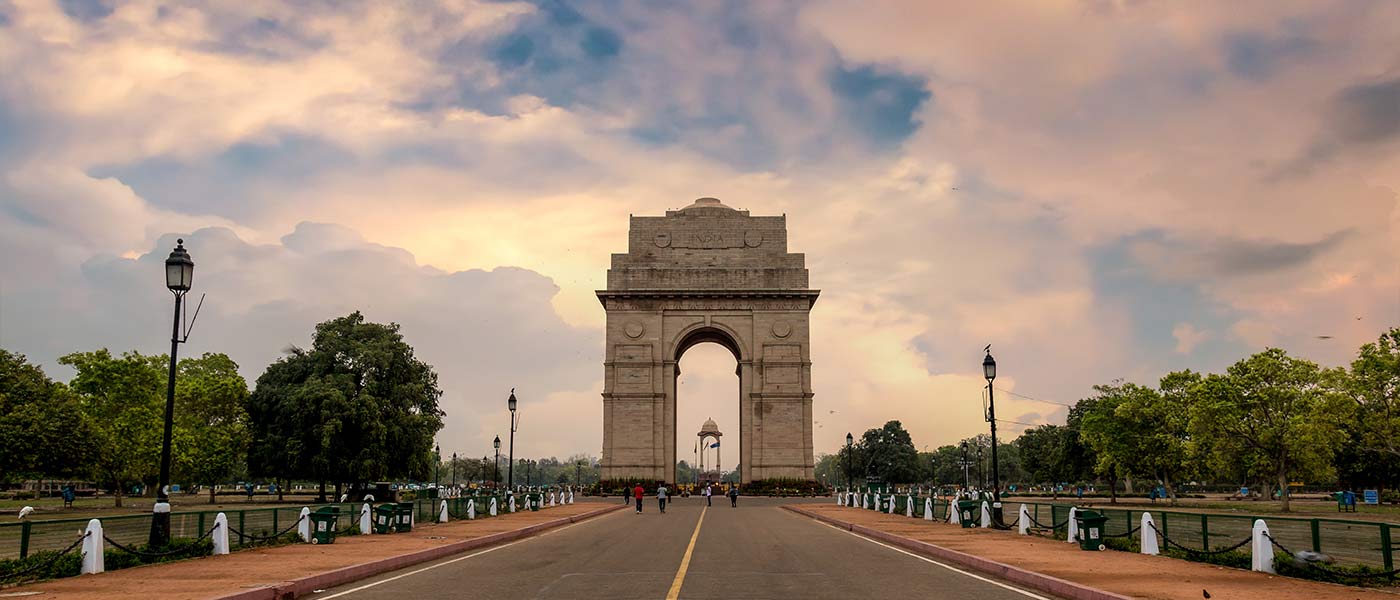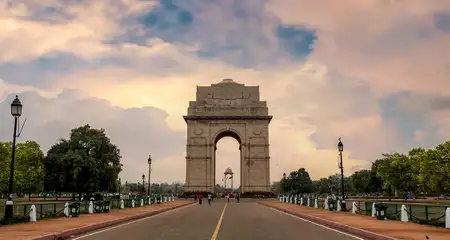The iconic India Gate, an arch gate made using sandstone, is a war memorial situated in the Rajpath area, Delhi. It was built to commemorate the Undivided British Army (also known as British India Army) soldiers who laid down their lives during the First World War and the Third Anglo-Afghan War of 1919. This imposing structure is one of the largest war memorials in the country with the names of over 13,000 soldiers written on it. Surrounded by lush green and well-manicured gardens, India Gate is a favorite spot among Delhiites, who enjoy their summer evenings and Sunday picnics here with families and friends. Formerly known as All India War Memorial, it is one of the top tourist attractions to explore once you check in at the hotels in Delhi.
Want to know more? From its history and architecture to timings, entry fee, and lesser-known facts, nearest metro stations to reach by, here’s everything you should know about the Indian Gate in Delhi.
India Gate Information:
| Location | Rajpath, New Delhi |
| Type | Memorial |
| Also Known as | All India War Memorial |
| Timings | Morning till evening; every day |
| Entry Fee | Free |
| Still and Video Cameras | Free |
| Architect | Edwin Lutyens |
| Architectural Style | Triumphal Arch |
| Period of Construction | 1921 to 1931 |
| Commissioned by | Imperial War Graves Commission |
| Dimensions | 42 meters (height) x 9.1 meters (width) |
| Area | 306,000 square meters |
| Material Used | Yellow and red sandstone and granite |
| Nearest Metro Station | Central Secretariat |
India Gate: History
This stupendous structure was constructed by the Imperial War Graves Commission aka IWCG, which was established in 1917 to build war memorials and graves for soldiers who lose their lives in the First World War. The memorial was designed by a famous English architect by the name Sir Edwin Lutyens and its foundation was laid by the Duke of Connaught, third son of Queen Victoria, on 10 February 1921. After 10 long years, on February 12, 1931, Viceroy Lord Irwin inaugurated and dedicated this structure to the nation and its future generations. The names of over 13,000 soldiers who lost their lives during the war are also inscribed on the memorial.
In the honor of soldiers who sacrificed their lives in the Indo-Pakistan War of 1971, a new structure was added to the India Gate in 1972. Known as Amar Jawan Jyoti (which means the Flame of the Immortal Soldier), this was inaugurated by Indira Gandhi, who was the then PM of India.
India Gate Architecture
Sir Edwin Lutyens, who designed the India Gate, was a leading war memorial architect and was also a member of IWGC. He built it as a secular memorial free of any religious association or cultural ornamentation. Also, Lutyens wanted the monument to be a classical one, so refused to incorporate any Asian motifs such as pointed arches. The architectural style of India Gate is that of a triumphal arch and is often compared with the Arc de Triomphe in Paris, the Gateway of India in Mumbai, and the Arch of Constantine.
Situated in the middle of a hexagonal complex, the structure is 42 meters tall and 9.1 meters wide. The whole structure is made using yellow and red sandstone which was brought in directly from Bharatpur.
About 150 meters towards the east of the India Gate, there is a canopy that was built in 1936 as a tribute to former Emperor of India, King George V. There used to be a marble statue of George V, but it was removed due to opposition from some political parties after India’s independence. Currently the statue is located in Delhi’s Coronation Park.
India Gate also houses a small structure called Amar Jawan Jyoti, which consists of a marble pedestal with a cenotaph on its top. The cenotaph has the words ‘Amar Jawan’ written on all four sides in golden letters and also has a reversed rifle, capped by a soldier helmet, installed on it. The structure is surrounded by permanently burning flames fueled by CNG on all the four sides.
India Gate: Today
Today, the India Gate holds much significance not only as a tourist attraction but also a symbol of nationalism. Every year, on 26th January, the Republic Day parade commences from the gates of the Rashtrapati Bhavan (the President’s residence) and progresses past the India Gate. Wreaths are placed at the Amar Jawan Jyoti by the Prime Minister of India on that day.
Things to Do at India Gate
- Every evening, this imposing structure is lit up with spotlights, making it one of the top tourist attractions to visit in Delhi during nights.
- The huge lawns surrounding the gate are a favorite spot for people to enjoy basket picnics, play cricket or indulge in kite flying.
- The Children’s Park located near the gate is a great place to spend some time with your kids.
- Rajpath, the boulevard on which the monument is located, is where many people, both young and old, come for early morning walks.
- Within a kilometer of India Gate, you will find Andhra Bhavan, one of the iconic restaurants in Delhi known for its lip-smacking traditional food.
- The Pandara Road Market, which is also located within walking distance of India Gate, is an amazing food market to experience Delhi’s street food flavors.
Lesser-known Facts about India Gate
- The names of the soldiers inscribed on India Gate include a female staff nurse who died during the war.
- It is said that the empty canopy behind the India Gate symbolizes the British retreat in India.
- Sir Edwin Lutyens also designed other important monuments in India including Viceroy House which is now known as the Rashtrapati Bhavan.
Attractions near India Gate
- National War Memorial (750 m)
- Children’s Park (900 m)
- National Gallery of Modern Art (1.4 m)
- Purana Qila (2.2 km)
- National Science Centre (2.5 km)
- Agrasen ki Baoli (2.5 km)
- Jantar Mantar (2.9 km)
- Rashtrapati Bhavan (2.7 km)
- Lodhi Garden (2.9 km)
- Connaught Place (4 km)
- Raj Ghat (5.2 km)
- Chandni Chowk (5.6 km)
- Jama Masjid (5.8 km)
Whether you are traveling with your friends, family or alone, a visit to this arch gate on Rajpath deserves to be on your list of things to do in Delhi. And don’t forget to take some amazing pictures with this iconic landmark as the background.




























